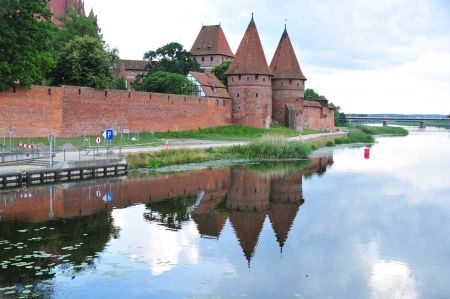The Marienburg on the right bank of the Nogat
- Written by Portal Editor
Even from a distance, the outlines of the towers and buildings of the Marienburg on the Nogat, an estuary of the Vistula, leave a first imposing impression of their size, thickness and importance, which must have once emanated from it.
With the start of construction in 1274, forty years after the beginning of the conquest of the Prussian region, the Landmaster of the Order Konrad von Tierberg the Elder began with the laying of the foundation stone. In the following decades, the fortress-like urban complex was further expanded.
Marienburg becomes a fortress city
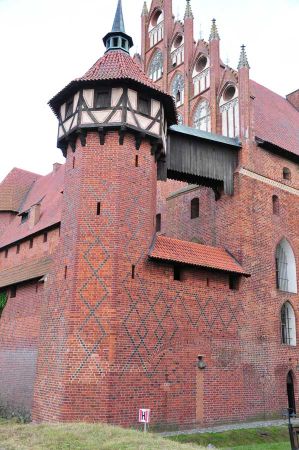 Two years later, to the southwest of the castle, construction on the town of the same name began, including a church, which was equipped with a "handfest". The German order of knights in Prussia used the term "handfest" for settlement documents. The locators received a handfest document for each new settlement to be founded. In it the rights of the locators for the founding of cities and villages were regulated, mostly the awarding of the office of mayor associated with "free hooves" and certain revenues (e.g. one third of the revenues from the lower jurisdiction - jurisdiction without the blood exclusively reserved for the order - and Halsgerichtsamkeit), as well as the court sizes, "freedoms" and "righteous" (especially mill, fishing and brewing rights and other privileges) of the settlers to be recruited from the old German areas and those of the new settlers to the order as landlords as money and Duties and services to be paid in kind tax. But now back to the fortress city.
Two years later, to the southwest of the castle, construction on the town of the same name began, including a church, which was equipped with a "handfest". The German order of knights in Prussia used the term "handfest" for settlement documents. The locators received a handfest document for each new settlement to be founded. In it the rights of the locators for the founding of cities and villages were regulated, mostly the awarding of the office of mayor associated with "free hooves" and certain revenues (e.g. one third of the revenues from the lower jurisdiction - jurisdiction without the blood exclusively reserved for the order - and Halsgerichtsamkeit), as well as the court sizes, "freedoms" and "righteous" (especially mill, fishing and brewing rights and other privileges) of the settlers to be recruited from the old German areas and those of the new settlers to the order as landlords as money and Duties and services to be paid in kind tax. But now back to the fortress city.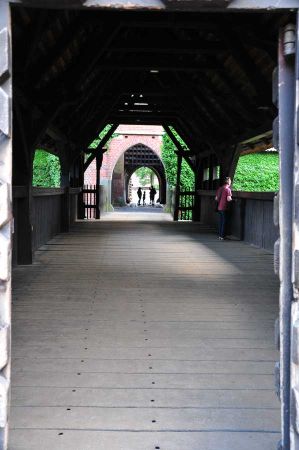 The north wing of the high castle with church and chapter house was completed by 1280. The outer bailey was rudimentary from 1309. The Grand Master's Palace was built from 1305 to 1393.
The north wing of the high castle with church and chapter house was completed by 1280. The outer bailey was rudimentary from 1309. The Grand Master's Palace was built from 1305 to 1393.
Since that time, the fortunes of town and castle could no longer be separated. In connection with the acquisition of Danzig and Pomerania, Grand Master Siegfried von Feuchtwangen moved the seat of the Order of Venice to Marienburg in 1309.
The Grand Master Winrich von Kniprode initiated the construction of the Neustadt in the last quarter of the 14th century and founded a Latin school. The Gothic town hall was completed in 1380, and around this time the Gothic city gates and the city wall were built.
First pillages and losses in Marienburg
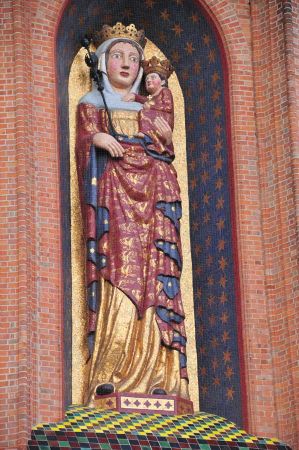 After the lost battle of Tannenberg in 1410, Grand Master Heinrich von Plauen had the city burn down except for church and town hall, retired with the residents to the castle and repelled the siege of the Marienburg. From 1411 to 1448 further enclosing structures, the Plauen bulwarks, were built.
After the lost battle of Tannenberg in 1410, Grand Master Heinrich von Plauen had the city burn down except for church and town hall, retired with the residents to the castle and repelled the siege of the Marienburg. From 1411 to 1448 further enclosing structures, the Plauen bulwarks, were built.
In 1454 the order had pledged the Marienburg with other castles of the order to the totality of the order's mercenaries as security for outstanding payments. A group of mercenaries under a Bohemian knight took control of Marienburg in 1457 and immediately sold it to the King of Poland Casimir IV. Andrew, called the Jagiellon, who moved in on June 7th and took possession of it. The Grand Master had just managed to escape the day before. He then moved his seat to Königsberg. The city of Marienburg had stood on the side of the order in the Prussian city war between the order and the Prussian Confederation and was recaptured on September 27th by mercenaries loyal to the order. Under the mayor Bartholomäus Blume it held out for three years against a siege by Polish troops and Prussian bundlers until August 6, 1460, but suffered severe damage.
And then the wars against the Swedish
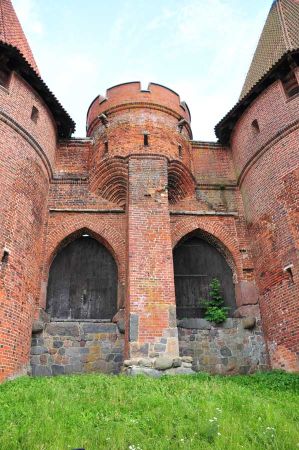 After the city was conquered, flowers were hanged and quartered.
After the city was conquered, flowers were hanged and quartered.
In the Second Peace of Thorn in 1466, the town and castle were transferred from the religious order to the autonomous corporate state of Prussia, the royal part, which had voluntarily submitted to the sovereignty of the Polish crown.
A Marienburg Voivodeship was established, which also included Elbing, Stuhm and Christburg. The church, which was destroyed in the city war, was rebuilt between 1468 and 1523.
However, the West Prussian cities received many privileges. During the two Swedish Wars 1626–1629 and 1656–1660, the city was continuously occupied by Swedish troops and the place was developed into a fortress.
Please read as well:
Kite- and windsurfing in the bay of Rewa
Short Visit to Wejherowo - Statue of Jakob von Weiher
